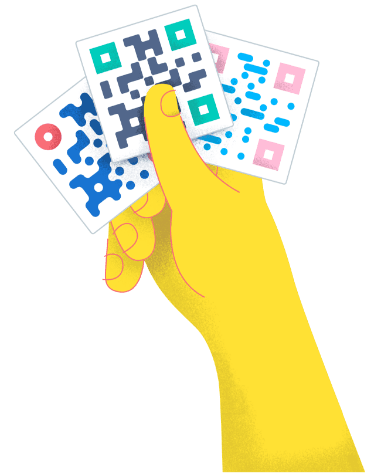- Best Practices ●
- COVID-19 ●
- Industry Trends ●
- Partners ●
- Product ●
QR Codes for Accessibility: Uses for People With Disabilities
Imagine a world that is a safe and inclusive space to roam, explore, and enjoy for all people, regardless of their health conditions or impairments. In our world, many people living with disabilities face the reality of imposed limitations, inaccessibility to certain spaces, and a lack of visibility in society.
Can tech shed some light on it? Sure it can! QR Code technology shows promising possibilities to empower people with disabilities. Still, we have a long road ahead.
This article expounds on the innovative ways brands are making an impact—both in small and large ways—for people living with various disabilities. We hope it can inspire more brands to create inclusive technology from which we can all benefit.
Are QR Codes accessible?
This question has two answers: yes, but also, not yet.
From the standpoint of the modern-day smartphone with a built-in QR Code scanner, absolutely. Today, many people living with disabilities have the power to decode QR Codes, thanks to the growing accessibility of smartphones and third-party scanning apps.
Still, there’s a long way to go before technology solves all accessibility issues. While QR Codes can help people with reading and memory disabilities, there are limitations for other individuals.
For example, people with visual impairments sometimes need help locating codes with their QR Code readers. Similarly, people with motor problems may need help scanning QR Codes, especially if they have shaky hands or lack the strength or mobility to hold up their devices.
But the future is hopeful. As technology evolves and phone cameras become more efficient at scanning QR Codes, more people living with disabilities may be able to access information easily.
Already, Google plans to unveil a long-distance QR Code scanning feature to allow longer barcode scanning distances. If implemented, people with motor problems may benefit, as they won’t need to zoom into QR Codes manually.
Examples of how to make QR Codes more accessible
While some aspects, like improving phone cameras’ scanning capabilities, may be out of your hands, you can still do a lot to increase accessibility for all. Here are some ideas on how you can make QR Codes more accessible for your loved ones or customers:
- Provide clear and concise instructions: This can help people with memory impairments or learning disabilities.
- Ensure the QR Code directs users to accessible links or media: This ensures your audience can benefit from your content. For example, you can verify that your links offer audio content to help people with no or low vision.
- Place QR Codes within easy reach for scanning: This prevents unnecessary struggles for users with limited mobility.
- Use a large QR Code size: Bigger QR Codes will make it easier for people with vision problems to spot your Codes.
- Use high-contrast colors: This will also make it easier for people to spot QR codes.
- Integrate audio or haptic feedback cues: This is another helpful tool for vision-impaired users.
5 QR Code use cases that can empower people with disabilities
To actualize the vision of a more inclusive and accessible world, many brands have invented new uses for QR Codes. Here are some inspiring examples of brands that have designed forward-thinking tech solutions that use QR Codes for accessibility.
1. Sound maps for navigation
The co-founder and CEO of a Spain-based tech company allied with researchers at the University of Alicante to create a solution that could support people using public transport who have no or limited vision.
The project took five years to complete, but they were able to design a mobile app and adapt existing tech so that people with visual disabilities could also use it.
A QR Code can be difficult to spot for people with limited vision, so they changed the look from a tiny, pixelated, patterned square to a bigger, clearer, color-blocked square.
In response to scanning, the app sends audio feedback to the user, giving alerts, instructions, and guidance for commuting on the bus, train, or tram. The transit system is available in Murcia, Madrid, and Barcelona and has now spread to New York as well.
This audio map is an atlas for the blind and visually impaired—and it’s making a big difference in the lives of many people who can now navigate public transport on their own.
Inspired? We love to witness businesses reinvent the use of QR Codes for public transport to make travel more accessible.
2. Accessible museum experiences
Suzanne Ragen, a docent at the Seattle Art Museum, founded “Art Beyond Sight,” a movement to help people with visual impairments enjoy art at the museum. The docent trained 15 guides in the museum to provide monthly tours to the visually impaired, with the goal of helping them explore art in almost the same capacity as other visitors.
Beyond the monthly tours, the museum created an exquisite pre-recorded guided tour for people with visual impairments, accessible via a QR Code for museums. When scanned, it gives you access to audio recordings that help you navigate the museum and its works.
These audio recordings bring art to the ears through detailed descriptions of the artwork, storytelling, and soundscapes. Stimulating the senses through sound, users hear art descriptions and commentary from artists, thought leaders, performers, and celebrities—an immersive sensory experience!
Exploring art sonically ignites the imagination of people with and without visual impairments. QR Codes on art offer an interactive, in-depth, and engaging art experience for people on any part of the visual impairment spectrum.
Artwork accompanied by a QR Code to listen to verbal descriptions of art.
3. Assistive technology to support students with hearing disabilities
Teachers at the Indiana School for the Deaf discovered an invaluable resource that assisted their students in reading stories in ASL (American Sign Language). We’ll cut to the chase—we’re talking about QR Codes.
This is how the teachers made the magic happen. They found 180 ASL stories on YouTube, generated them into a QR Code format, and then printed them onto storytelling cards.
Then they compiled a comprehensive document with detailed instructions on how to use QR Codes to access ASL content—including how to scan QR Codes with digital devices.
The document contains ASL stories like the well-known Dr. Seuss book, One Fish, Two Fish, Red Fish, Blue Fish, and Peggy Rathman’s classic Good Night, Gorilla. They’re available for anyone to scan and enjoy.
This resource shows how using a QR Code for school materials can liven up a classroom and help students engage with ASL stories independently, whether at school or at home. Turning to tech can elevate the learning experience for students with hearing disabilities in a simple yet engaging way and foster an inclusive learning environment.
Publishing houses could also widen the reading experience for people with hearing or visual impairments by printing QR Codes on books. Open up fictional and nonfictional worlds by creating a Video QR Code that links to an ASL video or an MP3 QR Code that leads to an audio description.
A QR Code in a book leads to an ASL video. Photo by Josh Applegate on Unsplash.
4. Inclusive packaging that empowers people with visual impairments
On World Sight Day in 2020, Kellogg’s launched a new packaging solution for people with partial sight and blindness in almost 60 stores in the UK.
How does this help people with visual disabilities? The new packaging has a unique QR Code that, when scanned, gives a voiced overview of the cereal. It provides product information like nutritional value and allergen info, which can be difficult to read for those with visual impairments.
This revolutionary idea to design a QR Code for product packaging came from a partnership between the Royal National Institute of Blind People (RNIB) and St. Vincent’s School. The latter is a specialist school focused on helping people with sensory impairments and other special needs.
The breakfast cereal company plans to change all of its packaging so that people with visual disabilities can have more autonomy when choosing their cereal.
Smart packaging, like that mentioned above, sets the bar high for how brands can start rethinking package design. It shows us what’s possible. Although we don’t yet have the software to create a unique kind of code that fully supports people with visual impairments, QR Code technology can still offer some assistance.
Creating QR Codes with highly contrasting colors, for example, can make them more visible to people with low vision. We hope this example serves as a catalyst to inspire more companies to rethink and reinvent package design.
5. An item finder that helps people with vision impairments
Identifying simple objects around the house can be a daily chore for people with limited or low vision, but one company’s innovative product is here to save the day.
Grailmaker Innovations created Spacefelt, a QR-Code-based tool that helps people with visual impairments find items easily. The product consists of waterproof QR Codes and an app to help identify items that visually impaired people have difficulty recognizing.
Here’s a sneak peek of how it works:
- Once you receive your booklet with 108 stickers, peel one off and place it on any item, like bottles, medication packaging, or even documents.
- Then, scan it using the app.
- When the app recognizes the QR Code label, you’ll get a prompt to record an audio description of the item.
- Scan the tag to test out if it worked.
In short, tag it and scan it. Once you finish tagging, it becomes easier to identify items around the house, eliminating the incessant frustration of trying to recognize objects that may be difficult to identify.
Aside from the regular sticker tags, the company has also created waterproof clothing labels that you can stitch onto clothing. It does require the help of a sighted person who can sew, but after that, you can use these labels to help identify or distinguish between clothing items.
While a visually impaired person may need some assistance with the set-up, once they have their items tagged and recorded, they can scan items with the app’s help. More independence, more empowerment!
People who are color-blind can borrow from this idea and use QR Codes on clothing to identify the colors of their clothes. This can reduce the risk of mismatching clothes.
QR Code clothing tags help people with color blindness find their clothing with ease.
Digital inclusion in the future
An estimated 1.3 billion people live with disabilities. This represents roughly 16% of the world’s population, making it vital for everyone to push for inclusion. Some countries, organizations, and individuals are already doing so.
On June 28, 2022, European policymakers passed legislation called the European Accessibility Act (EAA). The goal was to improve digital access for people with disabilities—pushing the envelope for companies to create products, services, and websites that are accessible to all.
As the EU paves the way forward, brands from other countries, especially those doing business in the EU, will have to up their game to comply with the new legislation. Ultimately, this is an opportunity to create a more inclusive world.
But you don’t have to wait for big brands to take steps to boost inclusivity. You can take a step now by helping wherever you can, in whichever capacity you can.
Create an MP3 QR Code to help people with low vision access a restaurant menu. Stitch a QR Code on your loved one’s clothes to help give them a bit more independence. Make QR Code bracelets to help people born mute communicate contact or health information. No action is too small to create the world you envision for tomorrow.
Create accessible QR Codes for all with QR Code Generator PRO
Although there’s still a long road ahead in making the world more accessible to people living with a diverse set of disabilities, tech innovation is making an impact.
If we keep accessibility at the forefront of product design, there’s room for more growth. Reimagining how we utilize these technologies is critical in creating a more inclusive world for everyone.
QR Code Generator PRO helps you contribute to a more inclusive world through accessible QR Codes. Using the tool, you can make life easier for people living with disabilities by allowing them to access information as easily as you would.
Sign up for QR Code Generator PRO today to create QR Codes that make information accessible to all of your friends, family, and customers.






 Add custom colors, logos and frames.
Add custom colors, logos and frames.

